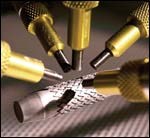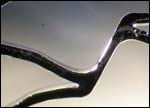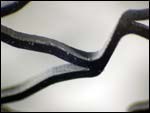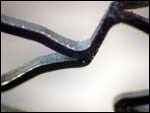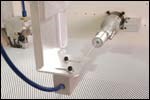Micro-Abrasive Blasting
Finishing small parts with pinpoint precision
Micro-abrasive blasting is a deceptively simple process. Often described as a miniature sand blaster, it is a process by which micron-sized particles are mixed with dry air. This mixture is then propelled out of a small nozzle tip at high velocity. The tight focus of the abrasive stream is what makes micro-abrasive blasting so unique. Without masking or shielding, blasting can be restricted to as small as 0.050 x 0.080 inch (1.3 x 2.0 mm). The most commonly known method for blasting involves an operator using a hand piece to blast parts in a workstation. Since its start in the 1960s, micro-abrasive blasting technology has been developed to better serve quantity production with the advent of automated solutions.
Replacing such methods for finishing small parts as the dremel, file, pick and other hand tools, micro-abrasive blasting is used to deburr, selectively clean, cut, remove material and prepare or texture surfaces. Alternatives to micro-abrasive blasting include large cabinet blasting, vibratory tumblers, hydro-jet abrasive blasting, lasers and ultrasonic cleaning. Though some of these methods may work better for certain applications, none can offer as much application flexibility as micro-abrasive blasting. The biggest perceived drawbacks to using micro-abrasive blasting technology are that it is low tech and dirty. Technological advancements however, have opened high-tech automated solutions for demanding production environments. This, combined with the increasing demand for small parts, has expanded the breadth of micro-abrasive blasting applications.
Featured Content
Micro-abrasive blasters find a home in a diverse group of industries from medical manufacturing to archeology. Machinists use micro-abrasive blasting to deburr Swiss precision machined parts, remove EDM recast and discoloration and finish and texturing mold cavities. Manufacturers use this process to clean and texture surfaces prior to plating. Micro-abrasive blasting is also used to clean airplane turbines and dental molds, to remove conformal coating on circuit boards and clean epoxy from probe cards. Many applications continue to be performed manually, but the development of more powerful blasters with high tech controls has made fully automated solutions possible. With a growing demand for smaller parts, micro-abrasive blasting is increasingly being chosen as an effective method that is cost-efficient for the single hand-held blaster to the multi-blaster automated system.
What makes micro-abrasive blasting so versatile is its ability to perform different processes on parts depending on several variables. The choice of abrasive, size and shape of the nozzle and amount of pressure applied all affect the end result. This gives the user the flexibility to use a micro-abrasive blaster to cut through one surface or deburr another simply by changing one or more of these variables.
The effect of an abrasive material is caused by its shape, hardness and particle size. Abrasives with particles that have points and edges will cut and strip away surface material on impact. Such sharp abrasives as crushed glass, aluminum oxide and silicon carbide are used to cut or deburr metals. Spherical-shaped particles such as glass bead however, do not have any cutting edges and are used to pound or “peen” a surface or to apply a satin-like finish. The hardness of a selected media determines the ability of the particle to remove layers of the work piece material. Harder particles such as aluminum oxide or silicon carbide will be more aggressive than plastic media or sodium bicarbonate. A larger particle generates a greater impact force as it strikes the work piece. This has two effects: it removes material faster and it tends to produce a heavier texture or rougher surface on the base material. Abrasive particles as small as 17.5 microns are used.
Nozzles are an integral part of the micro-abrasive blasting system. They provide focus and acceleration to the abrasive stream generated by the blaster. Round nozzles, the most common shape, produce a narrow, highly focused abrasive stream that results in an increase to the accuracy of the process. Rectangular or “slotted” nozzles are used where a wide sweep or fan of abrasive is required to clean larger areas. Other factors that differentiate nozzles include angled nozzles for blasting difficult-to-reach corners and extended nozzles for reaching inside narrow cavities.
Due to the wear and tear inherent in abrasive blasting, the quality of nozzle is key to the success of micro-abrasive blasting. Nozzles are generally manufactured with premium grade tungsten carbide for longer life.
The most common micro-abrasive blasting applications are performed manually. An operator holds the part and handpiece inside a workstation and controls the blast using a foot pedal. This controlled environment traps the spent abrasive, drawing it out of the work chamber. Workstations designed with downdraft technology provide exceptional airflow for efficient dust collection, keeping the work area clean throughout blasting.
Though manual blasting accounts for a large percent of micro-abrasive blaster use, several high-tech automated options are also in use. Micro-abrasive blasters can be integrated into automated systems for high volume production environments. Equipped with a splitter, more robust models can supply the abrasive stream to multiple nozzles. The addition of microprocessors enables monitoring of powder level, pressure, airflow and other critical components to ensure the system is functioning properly. A data port enables the microprocessor to communicate real time data to outside resource. It records operating time and blast cycles to facilitate timely maintenance.
One example of higher-powered blasters used in automation involves fuel injector ports. When cross-drilled holes are laser machined, a residue is left on the inside of the holes. Micro-abrasive blasting provided an effective method for removing the residue without damaging the surface finish. The challenge however, was to make this process efficient for a high volume production environment. To do this a more powerful model with several nozzles aligned was developed to blast several fuel injector ports simultaneously. The fuel injectors are placed in a tray and loaded into the machine. Long nozzles or right angle nozzles reach inside the center holes and blast the area with glass bead.
The introduction of micro-abrasive blasting lathes has brought a new level of precision and repeatability to the process. Used on any cylindrical product, the machine rotates the part on a spindle while one or more nozzles move precisely over it on the X-, Z- and W- axes.
The first models developed have manual controls that allow the operator to set spindle speed, blast speed, number of blast cycles and stroke start and stop positions. Most recent advancements however, include the capability to program all aspects of the blast routines through a user-friendly interface. The operator is guided through a step-by-step process on an LCD screen. Smart tooling checks that the proper blast head is installed and prompts the user to load the appropriate tooling. It also alerts the operator to any errors throughout the process with warning messages on the screen. This facilitates easy operation of the machinery and reduces the risk of human error.
Before being put into the hands of a production operator, blast programs must be developed, tooling created and nozzles positioned. Tooling is required to hold the part in such a way that all the necessary areas can be reached by blasting. Initial tooling is developed by lathe manufacturers to hold a specific part or parts. An OD engineering blast head with up to 13 adjustments is used for precise alignment of the nozzles. This head is ideally suited for prototype and development work. Once correctly positioned, a fixed had can be fabricated for production. The set positions of the fixed head prevent the operator from accidentally changing nozzle alignment. An ID blast head uses a long, extended right-angle nozzle to blast from the inside of small openings. Finally a blast cycle is programmed to trace complex patterns with adjustments for both speed and acceleration. With multiple axes control, advanced lathes are not limited to processing cylindrical devices. They are also capable of mixing a variety of motions to clean the intricate shapes of cutting edge devices.
The initial tooling and blast programs are designed by the micro-abrading lathe manufacturers for specific parts. Further tooling and blast programs are then most often developed by the parts manufacturers as an addition to their own research and development.
A typical abrading lathe application is the removal of the oxide layer and pulse lines left on NiTinol stents following laser cutting. Medical implant devices are susceptible to corrosion and a smooth finish on their surfaces reduces vulnerability. The oxide layers and discoloration generated by the laser machining process prevent electro-polishing from imparting this desired finish. Stents must also be free of the sharp edges that result from laser machining. A small radius can be imparted to the edges by blasting one or both ends to reduce the sharpness. The strut running along the axis of a stent can be rounded with micro-abrasive blasting to eliminate the sharpness of the strut’s edge.
Micro-abrasive blasting is used to eliminate the “remelt” from strut junctions. This occurs where the residual laser slag re-bonds itself to the device, compromising its reliability. Blasting to remove the “remelt” restores uniformity to the material surface and removes the potential for small pieces of laser slag to break off with age.
Laser machining also leaves small cavities or micro-cracks on the base material. The cracks corrode with time, becoming larger, eventually weakening the structural integrity of the implant. Micro-abrasive blasting effectively removes the cracks, reducing the risk of device failure.
Stent processing is generally done in two steps to completely blast the surfacefrom both the inside and outside. The operator selects the program and loads one or more stents onto a long cylindrical mandrel as indicated on the screen. With the OD blast head in place, the program begins blasting the outside of the stents from five nozzles. After the blast cycle is complete, the operator is instructed to change the tooling. The stents are loaded into a clamshell mandrel and the OD blast head is switched for the ID head. A quick-change feature facilitates changing between the OD and ID blast heads. Once the proper tooling and head have been loaded the second step of the blast cycle starts. The long nozzle is inserted in the clamshell where it blasts the stents from the inside.
Though micro-abrasive blasting may be compared to grit or cabinet blasting, its pinpoint accuracy for blasting small sections sets it apart. Micro-abrasive blasting can’t compare to laser cutting and drilling or hydro-cutting of many hard metals, but it does have a place for some cutting applications. The shockless, no heat or vibration characteristics of micro-abrasive blasting make it an effective tool for cutting slots in silicon wafers. When not used for the most effective method for cutting, micro-abrasive blasting serves another function: to clean up the residue left by lasers. When it comes to other methods fit for a small scale, the application and production quantity make a difference. Choosing a micro-abrasive blasting system depends on how often it would be used, how precise the application needs to be, whether automated or multiple nozzles arrays are needed, and the surface area that needs to be blasted. There is a wide range of options on the market including units that can be used as OEM devices to integrate into a custom system built in-house.
Advancements in micro-abrasive blasting have created a versatile technology that is used across a wide range of industries. Developments in automation have improved efficiency for quantity production and broadened the field of applications that can benefit from the process. A wide range of models, accessories and abrasives make micro-abrasive blasting not only an efficient process for manual applications but automated applications as well.



